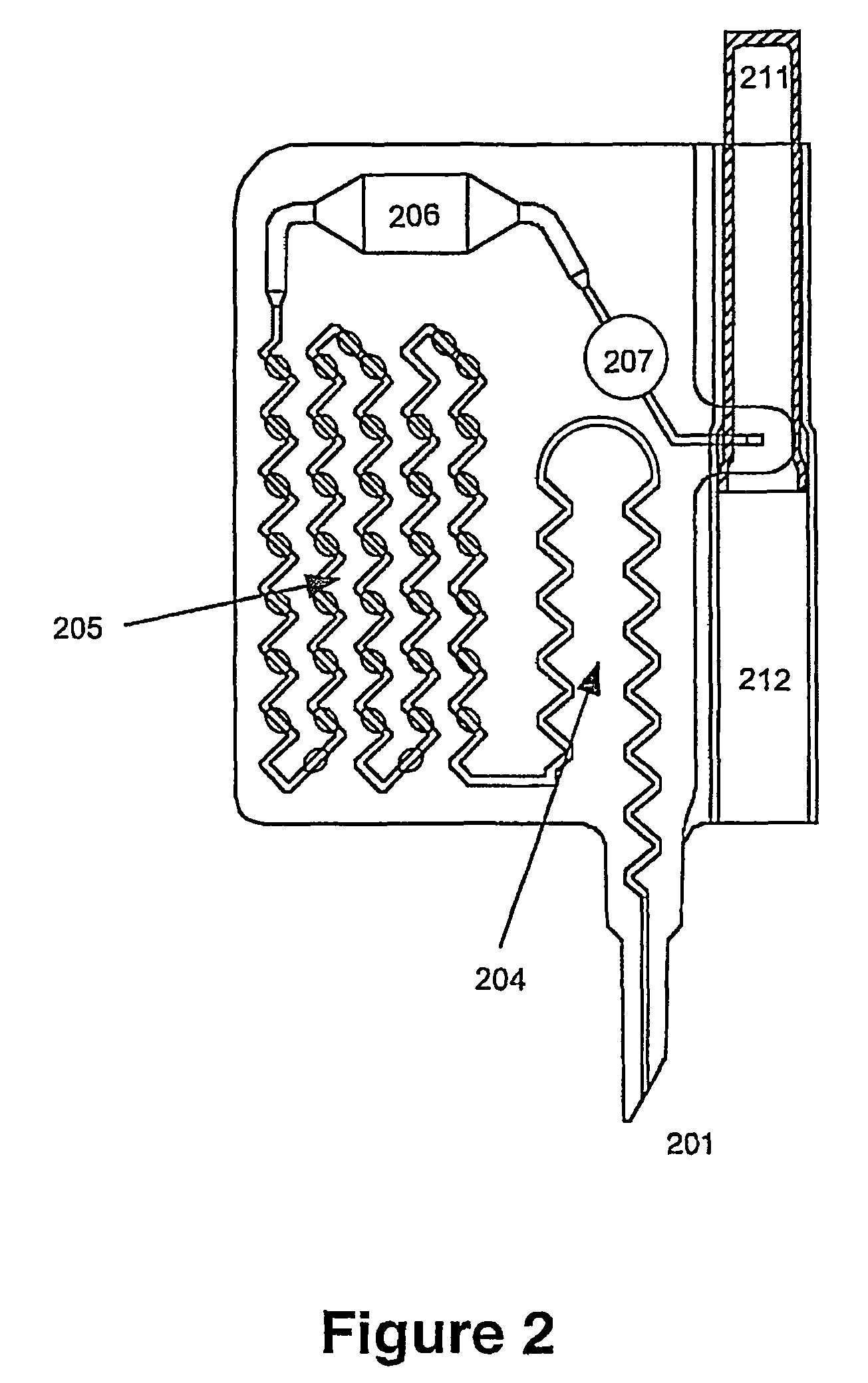Method for the assessment of particles and a system and device for use in the method
a particle and particle technology, applied in the field of particle and particle assessment, can solve the problems of high complexity and cost of the instruments used today
- Summary
- Abstract
- Description
- Claims
- Application Information
AI Technical Summary
Benefits of technology
Problems solved by technology
Method used
Image
Examples
example 2
[0181]Principle for the Assessment of Bacteria in Water Retained on a Filter Device.
[0182]A disposable device, similar to the one described in relation to FIG. 2, with a modification where filter means, capable of substantially retaining any bacteria passing the filter means, are placed in the sample compartment 204 and arranged in such a way that signals from particles retained on the filter means are exposed to the exterior, and where suitable reservoir is placed between the sample compartment and the valve 205 with volume capable of holding the volume of sample passed through the filter.
[0183]The filter means could be a filter capable of retaining the bacteria to be assessed, for instance it could be a filter with an average pour size of 0.22 μm. The filter is placed in the sample compartment, arranged substantially parallel to a window of the sample compartment allowing signals from particles retained on the filter means to pass to the exterior and be detected by detection means...
example 3
The Assessment of the Number of Somatic Cells in a Volume of Milk According to the Present Invention.
[0186]104 raw milk samples from individual cows were collected and measured on a FossoMatic (Foss Electric, Denmark) in order to obtain an estimate of a reference value for the number of somatic cells in volume of milk. For comparison portions of the same samples were measured in a device according to the present invention as described in relation to FIG. 2.
[0187]The sample compartment of the devices used for the analysis was on average about 67 μm in thickness, with a variation of about 1 μm expressed as one standard deviation of the measured thickness. The effect of varying thickness of the sample compartment was not compensated for in the results.
[0188]Prior to analysis the reaction compartment of the device was loaded with approximately 6 μl solution containing Propidium Iodide (0.06% w / w), Triton X-100 (3.5% w / w) and Ammonium Chloride (7% w / w). The solution was dried in hot air ...
example 4
[0191]The Assessment of the Number of White Blood Cells in a Sample of Human Whole Blood According to the Present Invention.
[0192]9 samples of human whole blood were measured on a standard routine cell counter (unknown fabricate) in order to obtain an estimate of a reference value for the number of white blood cells in volume of human blood. For comparison portions of the same samples were measured in a device according to the present invention as described in relation to FIG. 2. Each sample was measured twice in two separate devices.
[0193]The sample compartment of the devices used for the analysis was on average about 41 μm in thickness, with a variation of about 0.7 μm expressed as one standard deviation of the measured thickness. The effect of varying thickness of the sample compartment was compensated for in the results.
[0194]Prior to analysis the reaction compartment of the device was loaded with approximately 6 μl solution containing Propidium Iodide (0.03% w / w), Triton X-100 ...
PUM
| Property | Measurement | Unit |
|---|---|---|
| depth | aaaaa | aaaaa |
| depth | aaaaa | aaaaa |
| volume | aaaaa | aaaaa |
Abstract
Description
Claims
Application Information
 Login to View More
Login to View More - R&D
- Intellectual Property
- Life Sciences
- Materials
- Tech Scout
- Unparalleled Data Quality
- Higher Quality Content
- 60% Fewer Hallucinations
Browse by: Latest US Patents, China's latest patents, Technical Efficacy Thesaurus, Application Domain, Technology Topic, Popular Technical Reports.
© 2025 PatSnap. All rights reserved.Legal|Privacy policy|Modern Slavery Act Transparency Statement|Sitemap|About US| Contact US: help@patsnap.com



